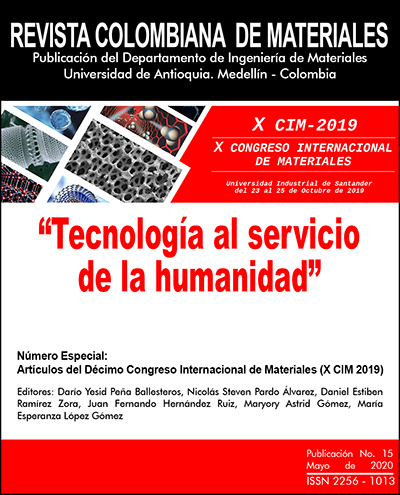Valoración de las propiedades mecánicas de la aleación Cu-8Sn refinada con zirconio
DOI:
https://doi.org/10.17533/udea.rcm.342064Palabras clave:
“as cast”, inoculación, bronces, zirconio, ensayos mecánicosResumen
El refinamiento de grano realizado a través de inoculación de aleaciones de bronces fosforados “as-cast” ha sido estudiado durante varios años con el propósito de establecer una metodología efectiva que permita obtener aleaciones con estructura de granos refinados y sin la necesidad de aplicar tratamientos térmicos a las aleaciones producidas. En la presente investigación se estudió el efecto refinador del zirconio en el tamaño de grano y en las propiedades mecánicas (dureza y tracción) de la aleación (Cu8%pesoSn) “as cast”; para ello se fabricaron dos aleaciones Cu8Sn y Cu8Sn0,32Zr. Estas se produjeron por medio de fundición y vaciado en molde de arena aglomerada con resina fenólica; una vez producidas las aleaciones se fabricaron piezas de acuerdo con la norma ASTM B208-14. Las piezas obtenidas fueron cortadas y maquinadas para producir probetas de tensión, con el propósito de realizar ensayos de tensión y dureza, además de realizar análisis fractográfico. Los resultados arrojaron que la resistencia última a la tensión, el límite de cedencia, la dureza Brinell y el esfuerzo de rotura de la aleación Cu8Sn0,32Zr fue mayor que la de Cu8Sn. De igual manera se obtuvo una reducción de 85% en el tamaño medio de grano en la aleación Cu8Sn0,32Zr.
Descargas
Citas
W. Reif and G. Weber, “Grain refining copper alloys, UK patent GB2179673A.” pp. 1–13,
Maxwell, I. and A. Hellawell, Simple Model for Grain Refinement During Solidification. Acta Metallurgica, 1975. 23(2): p. 229-237.
Turnbull, D.; Vonnegut, B. "Nucleation catalysis", Industrial and Engineering chemistry, Vol.44, n. 6, pp. 1292-1298, 1952.
M. Johnsson, L. Backerud, and G. K. Sigworth, “Study of the mechanism of grain refinement of aluminum after additions of Ti- and B-containing master alloys,” Metall. Trans. A, vol. 24, no.2, pp. 481–491, 1993.
Greer, A.L., et al., Modeling of inoculation of metallic melts: Application to grain refinement of aluminum by Al-Ti-B. ActaMaterialia, 2000. 48(11): p. 2823-2835.
Tarshis, L.A., J.L. Walker, and J.W. Rutter, Experiments on Solidification Structure of Alloy
Castings.Metallurgical Transactions, 1971. 2(9): p. 2589-&.
A. Couture and J. O. Edwards, Grain refinement of sand cast bronzes and its influence on their properties., AFS transactions.1973; 32: 453-461
J. M. Rojas Arango, “REFINO DE GRÃO DAS LIGAS DO SISTEMA COBRE-ESTANHO” Escola Politécnica da Universidade de São Paulo, 2016.
ASTM, “ASTM B208-140: "Standard Practice for preparing tension test specimens for Copper Alloy Sand, Permanent Mold, Centrifugal and Continuous Castings1", ASTM, vol. 96, no Reapproved, pp. 1-9,2015
ASTM, “ASTM E8: Standard, A., E8," Standard Test Methods for Tension Testing of Metallic Materials. Annual book of ASTM standards, 2004. 3: p. 57-72.
ASTM, “ASTM E112-13: Standard test methods for determining average grain size,” ASTM Int., pp. 1–28, 2013.
Garcia,Amauri, "Macroestruturas de solificacao", In: "Solidificacao Fundamentos e Aplicacaoes", Livro Texto, 1sted., ch. 8, Editora da Unicamp, Brasil, 2001.
A. Green, J. Wesemael: Die cast eng., 2009, vol. 03, pp. 56-56
M. Möser, “Chapter 15 Fractography with the SEM (Failure Analysis),” Mater. Sci. Monogr.40 Electron Microsc. Solid State Physics., 2007.
Descargas
Publicado
Cómo citar
Número
Sección
Licencia
Derechos de autor 2020 Revista Colombiana de Materiales

Esta obra está bajo una licencia internacional Creative Commons Atribución-NoComercial-CompartirIgual 4.0.








